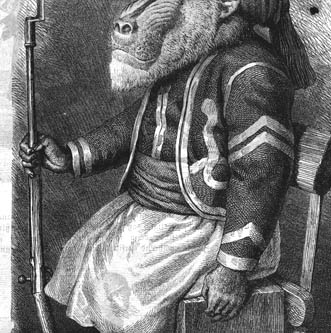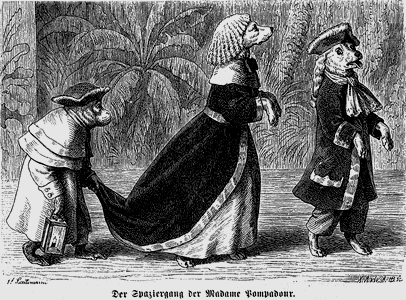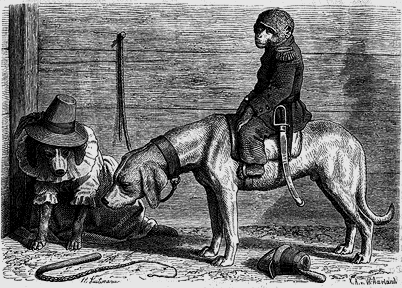Open Access
Distinction
Julia Voss


"If the difference of staff is not taken into account, monkeys on stage resemble much more a standard human stage than one would usually assume [...]. Praise and blame get distributed by the highest standard of justice and tact and do not fail to have the desired effect like on real stage; but apelike praise is sometimes enhanced by a raisin or the like, blame in rare cases by a soft stroke which draws a fine distinction to the human stage."

It was this sort of distinction between apes and humans which was so carefully studied by the animal illustrator H. Leutemann in the popular weekly journal "Die Gartenlaube" that was vehemently debated in 1871. At the very same time the striking humanness of dressed up monkeys was being celebrated in Broekmann's ape theatre in Leipzig, Charles Darwin published his book on "The Expression of the Emotions" (1872). In this book the wrinkling of the forehead, the pulling of the face or the wide opening of the eyes that was comedy on Broekmann's stage was turned into evidence for the natural bond between man and animals. Yet, grasping the kind of moment that could be so easily observed by the visitors of zoos, pet-keepers or the audience in animal theaters proved to be a great challenge to the animal illustrator. Leutemann was frequently asked whether animals keep still while being portrayed and to his regret he had to contradict this picture. His colleague, Gregor Mützel, described the difficulties as follows:
"The main obstacle for the artist arises from the close contact with the animal itself and can only be mastered by relentless patience and tricks. It is obvious how the movement of the animals especially that of the ceaselessly fidgety apes hinder the artist's effort to fixate the right picture."

Since the animal mimics were faster than the actual moment that could be captured by photography in those days, the animal painter was forced to persuade the animal to repeat the same movement over and over again until the same gesture had been observed so many times that it could confidently be put onto paper. Nevertheless, in contrast to an animal trainer who achieved repetition by praise and blame the animal painter had to figure out an experimental system which had to guarantee that the animal's movement was natural and spontanous and at the same time repetitive in order to make the moment last. To achieve this, the animals' confusing agility as well as its disturbing lethargy had to be stopped, as Mützel put it:
"The laziness of animals is no less disturbing to the painter [...] and is bound to be eliminated by the throwing of a stone, the clapping of the hands, the crack of a whip or the sound of a horn [...]. In that manner the characteristic creeping of a genet cat was successfully portayed on paper by repeatedly touching the tip of the animal's tail since that caused the animal to walk back and fro in the cage. On a different occasion a bodypart of the capybara was sprinkled with salt so that the animal was kept in the same posture by licking off the the substance from its body."
In the case of the genet cat or the capybara (a southamerican rodent) the desired picture was the one that pictured the animal while exercising a movement that was believed to be typical for its species. Yet, as Leutemann stressed in his article "typical" was defined differently with the "Mister ape, since the natural scientist had granted them a space so close to us". Henceforth the audience as well as the scientist and the illustrator were craving for a picture of the utmost affinity. No matter whether on stage, in texts or in images: The desired sensation was the disappearance of distinction between man and animals in 1871.
VL Essays
- Permalink (old)
- http://vlp.uni-regensburg.de/references?id=art6